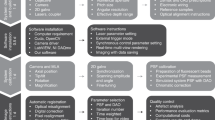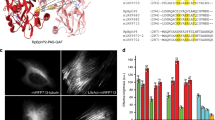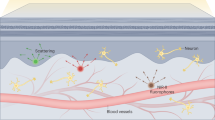Abstract
As small-animal fluorescence imaging becomes increasingly accessible to a broad spectrum of users, many lab animal researchers are just beginning to be exposed to its challenges. One setback to fluorescence imaging is background autofluorescence generated in animal tissue and in ingested food. The authors bring this issue into focus, and show how autofluorescence can be reduced in nude mice through selection of appropriate excitation wavelength and mouse diet.
This is a preview of subscription content, access via your institution
Access options
Subscribe to this journal
We are sorry, but there is no personal subscription option available for your country.
Buy this article
- Purchase on Springer Link
- Instant access to full article PDF
Prices may be subject to local taxes which are calculated during checkout



Similar content being viewed by others
References
Massoud, T.F. & Gambhir, S.S. Molecular imaging in living subjects: seeing fundamental biological processes in a new light. Genes Dev. 17, 545–580 (2003).
Troy, T., Jekic-McMullen, D., Sambucetti, L. & Rice, B. Quantitative comparison of the sensitivity of detection of fluorescent and bioluminescent reporters in animal models. Mol. Imaging 3, 9–23 (2004).
Ntziachristos, V., Ripoll, J., Wang, L.V. & Weissleder, R. Looking and listening to light: the evolution of whole-body photonic imaging. Nat. Biotechnol. 23, 313–320 (2005).
Ntziachristos, V. Fluorescence molecular imaging. Annu. Rev. Biomed. Eng. 8, 1–33 (2006).
Weagle, G., Paterson, P.E., Kennedy, J. & Pottier, R. The nature of the chromophore responsible for naturally occurring fluorescence in mouse skin. J. Photoch. Photobiol. B 2, 313–320 (1988).
Frangioni, J.V. In vivo near-infrared fluorescence imaging. Curr. Opin. Chem. Biol. 7, 626–634 (2003).
Hawrysz, D.J. & Sevick-Muraca, E.M. Developments toward diagnostic breast cancer imaging using near-infrared optical measurements and fluorescent contrast agents. Neoplasia 2, 388–417 (2000).
Wagnieres G.A., Star, W.M. & Wilson, B.C. In vivo fluorescence spectroscopy and imaging for oncological applications. Photochem. Photobiol. 68, 603–632 (1998).
Tromberg, B.J. et al. Non-invasive in vivo characterization of breast tumors using photon migration spectroscopy. Neoplasia 2, 26–40 (2000).
Shah, K. & Weissleder, R. Molecular optical imaging: applications leading to the development of present day therapeutics. NeuroRx 2, 215–225 (2005).
Reeves P.G., Nielsen F.H. & Fahey, G.C. AIN-93 purified diets for laboratory rodents: final report of the American Institute of Nutrition ad hoc writing committee on the reformulation of the AIN-76A rodent diet. J. Nutr. 123, 1939–1951 (1993).
Acknowledgements
The authors thank Christoph Hergersberg for funding this project and for his support and suggestions.
Author information
Authors and Affiliations
Corresponding author
Ethics declarations
Competing interests
The authors declare no competing financial interests.
Rights and permissions
About this article
Cite this article
Bhaumik, S., DePuy, J. & Klimash, J. Strategies to minimize background autofluorescence in live mice during noninvasive fluorescence optical imaging. Lab Anim 36, 40–43 (2007). https://doi.org/10.1038/laban0907-40
Received:
Accepted:
Issue Date:
DOI: https://doi.org/10.1038/laban0907-40
This article is cited by
-
iRFP (near-infrared fluorescent protein) imaging of subcutaneous and deep tissue tumours in mice highlights differences between imaging platforms
Cancer Cell International (2021)
-
Lanthanide-doped near-infrared II luminescent nanoprobes for bioapplications
Science China Materials (2019)
-
1.3 μm emitting SrF2:Nd3+ nanoparticles for high contrast in vivo imaging in the second biological window
Nano Research (2015)



